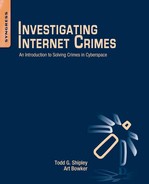Table of Contents
Chapter 1. Introduction to Internet Crime
CSI 2010/2011 Computer Crime and Security Survey
Norton™ Cybercrime Report 2011
HTCIA 2011 Report on Cybercrime Investigation
2012 Data Breach Investigations Report
Internet Crime Compliant Center
Traditional crimes and the Internet
Investigative responses to Internet crime
Why investigate Internet crime?
What is needed to respond to Internet crime?
Continuing investigative problems
Chapter 3. How the Internet Works
A short history of the Internet
The importance of IP addresses
Other services on the Internet
Chapter 4. Collecting Legally Defensible Online Evidence
Chapter 5. Documenting Online Evidence
Process for documenting online ESI
Tools/techniques for documenting Internet evidence
Authenticating the collected evidence
Validation of online evidence collection tools
Collection from Apple Macintosh
Chapter 6. Using Online Investigative Tools
The Internet Investigators Toolkit
Chapter 7. Online Digital Officer Safety
Online investigative computer protection process
Cloning or image the investigator’s computer
Keeping your investigative computer secure
Chapter 8. Tracing IP Addresses Through the Internet
Digging deeper into IP tracing—what the DNS tells us
Faking an email and hiding its sender
Collecting email from a web-based system
Relevant RFCs related to IP tracing
Chapter 9. Working Unseen on the Internet
Tracking criminals who use anonymous methods to hide
Chapter 10. Covert Operations on the Internet
Covert operations on the Internet
“On the Internet no one knows you are a dog” (Fleishman, 2000)
Chapter 11. Conducting Reactive and Proactive Internet Investigations
Reactive versus proactive investigations
Managing undercover Internet investigations
Chapter 12. Internet Resources for Locating Evidence
Finding information on a person
Finding telephone numbers and email addresses
Chapter 13. Investigating Websites and Webpages
Documenting a website’s multimedia and images
The legal process of identifying a website
Chapter 14. Investigating Social Networking Sites
Social networking’s impact on legal systems
Starting a social networking site investigation
The top social networking sites
Examining social networking sites
Application program interface and social media content
Online social versus professional networking
Finding individuals on social media sites
Social media evidence collection
Social networking through photographs
Social media investigations policy
Training on investigating social networks
Chapter 15. Investigating Methods of Communication
Client server: protocols and tools
Chapter 16. Detection and Prevention of Internet Crimes
Perception of law enforcement on the Internet
Contributing factors to the problem
Law enforcement’s response to internet crime
Investigator cybercrime education
What can you do to detect and prevent online crime?
Chapter 17. Putting It All Together
Basic Internet investigative steps
Appendix A: HEX to ASCII Conversion Chart
Appendix B: Stored Communications Act Quick Reference Guide: USDOJ Search and Seizure
Appendix C: Online Crime Victim Interview
Appendix D: Internet Investigations Report Format
Appendix E: Digital Officer Safety Computer
Appendix F: Router Setup Checklist
Appendix G: Tracing Email Worksheet
Appendix H: Undercover Persona Worksheet
Appendix I: Model Policy For LE Investigative
Appendix J: Model Policy For Off-Duty LE
Appendix K: Investigating A Person Online
Appendix L: Investigating A Website Worksheet
